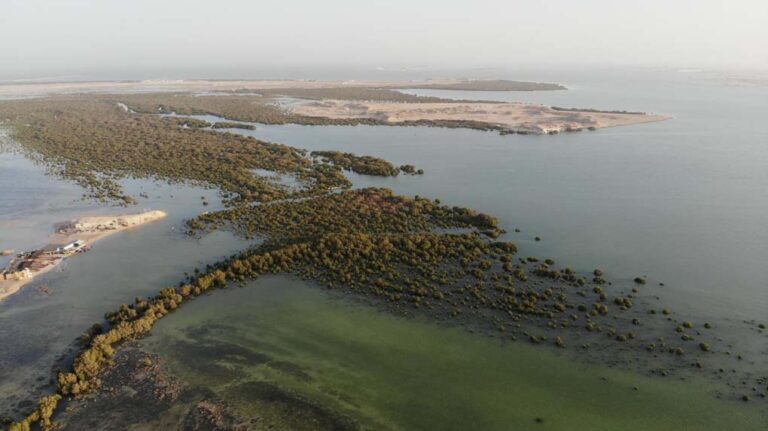Doha’s towering skyscrapers sit glistening in the blazing sun, majestically overlooking the luminous, turquoise waters of the Persian Gulf. Just further down the road, clustered near the iconic Museum of Islamic Art, a group of traditional, wooden dhow boats sit anchored to the moors, waiting patiently for their next fishing adventure. It’s a picture-perfect scene, rooted in the past and future, and an important reminder of Qatar’s undeniable history and connection to the sea.
Before the discovery of oil and gas, Doha was a quiet and sleepy town steeped in tradition and community. Dependent on the sea for pearl diving and fishing, Qatar was a perfect spot for international maritime trade with travelling merchants exchanging goods such as sandalwood and spices. Nowadays, Qatar’s maritime past can be seen in places such as Souq Waqif, the National Museum of Qatar, and annual celebrations such as the Dhow Festival.
As a small peninsula, Qatar has 560 kilometres of coastline that offers opportunities for rest, relaxation, and recreation. It hosts small historic villages, bustling industrial cities, and luxurious five-star hotels. From beach camping to kitesurfing and sailing, there’s an increasing number of sea-based activities to make the most of Qatar’s stunning clear waters. During the blistering summer months, as the sun drops down on the horizon, beaches provide a cool haven to beat the heat.
Surprisingly, despite the hot and arid desert environment, Qatar is home to one of the most important coastal marine ecosystems in the world—mangroves. These woody, green oases, found in a handful of places throughout Qatar, are teeming with an abundant array of plant and animal life and are a true force of nature.
What Are Mangroves?
Mangroves are salt-tolerant, highly specialised ecosystems of trees and shrubs that grow along coastlines and estuaries around the planet. The most significant areas of mangroves are found in tropical and subtropical regions such as Asia and Central and North America.
Mangrove trees usually have dense canopies and thick, complex root systems that anchor into the soil and provide the perfect protective habitat for a unique variety of marine and terrestrial (land) wildlife to hide and breed. Typical of mangroves, the pointy aerial/pencil roots that rise from the soil allow the trees and plants to absorb oxygen.

DID YOU KNOW? Indonesia has the largest area of mangroves on the planet.
Why Are Qatar’s Mangroves Unique?
Home to the white or grey Avicennia marina tree species, Qatar’s mangroves have survived the harsh desert conditions and low rainfall to create flourishing, green ecosystems for an array of permanent and migratory animals.
Each year, a variety of bird species stop in Qatar on the way to their final destination. The world’s largest flamingo species, Greater flamingo, migrate from colder European temperatures to rest and replenish in Qatar’s warm mangroves before recommencing their long journey to Africa.
DID YOU KNOW? Compared to other countries, Qatar has shallow coastal waters. This makes the salinity (salt level) of the water and its temperature one of the world’s highest.
Why Are Mangroves Important?
Mangroves are nature’s eco-warriors against global warming and help to support the planet in many ways. Their sturdy root systems stabilise soil and create a protective barrier against coastal decline and erosion from oncoming tidal waves, wind, and storms. Tree roots help trap and filter sediments, salt, pollutants, and particles to improve water quality and protect nearby marine ecosystems such as coral reefs and seagrasses.
Mangroves are considered one of the most important ecosystems to reduce climate change. Poisonous carbon dioxide gases, released from burning fossil fuels and landfills, are absorbed by mangrove trees and stored. In fact, mangroves can store more carbon than any other forest on the planet.
DID YOU KNOW? Found on coastlines that connect the land with the sea, mangroves encourage biodiversity above and below the water by attracting various land and sea animals to feed and breed.
Where to Find Mangroves in Qatar
Qatar’s mangroves provide a unique opportunity to discover an important ecosystem of local flora and fauna. Located around the coastline, mangroves can be found in areas such as Al Ruwais, Simaisma, and Fuwairit. Nowadays, kayaking tours are becoming a popular activity to gain a close-up experience of these natural wonders, and several adventure companies organise daily tours. The most abundant mangroves are found near the northern seaside city of Al Khor:
Al Thakira – this green expanse is one of the oldest and largest mangroves in Qatar. During the winter months, the shallow waters provide the perfect resting spot for migratory flamingos and other birds to replenish on small fish before restarting their journey to Africa.
Purple Island – this small, rocky island is accessible from the mainland by a long wooden pedestrian bridge overlooking the mangroves. Three thousand years ago, the island was famous for its purple dye produced from crushed sea snail shells and was coveted by royalty and the ruling classes.
Environmental Challenges
Mangroves are one of the most threatened ecosystems in the world. Pollution, climate change, rising sea levels, and tourism contribute to the loss of mangroves. Lack of environmental protection has reduced approximately 30% of the world’s mangrove surface area.
In Qatar, the Ministry of Municipality and Environment (MME), local environmental action groups, and tour operators have organised awareness and cleanup campaigns to protect the mangroves. Tree cutting and planting have also helped to regenerate certain areas.
DID YOU KNOW? With increasing tourism, urban development, and pollution, Qatar’s mangroves are still vulnerable to damage.
Help Protect Qatar’s Mangroves
When visiting the mangroves, follow these handy tips to protect the environment for future generations:
- Avoid the pencil roots that pop up from the soil—these are part of the mangroves’ root systems and help the trees to absorb oxygen.
- Always take your rubbish with you. Human-made plastic items such as water bottles, bags, containers, and wrapping can be ingested or suffocate wildlife.
- Always stick to paths or designated areas.
- Look but don’t touch—avoid moving wildlife and plants.
Qatar e-Nature Mangrove Treasure Hunt
Suitable for all ages, Qatar e-Nature is a free, downloadable application developed by Sasol in association with Friends of the Environment Centre (FEC) to promote sustainable development. The application provides detailed information and photos on plants, birds, insects, mammals, reptiles, and marine and terrestrial (land) life in Qatar. Since 2014, Qatar e-Nature has organised an annual school contest to create environmental awareness.
Can you find the following wildlife at the mangroves? What other animals did you see?
- Crabs
- Snails or slugs
- Fish
- Shrimp
- Mudskippers
Article sources:
- Qatar National Library (QNL)
- Visit Qatar
- Food and Agriculture Organization of the United Nations (FAO)
- Qatar e-Nature
- Qatar Marine
Doha Family would like to thank Qatar e-Nature for supplying images for this article.



